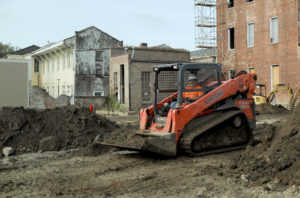
This is the case of a General Contractor in Canada who attempted to extend the deadline to file a lien by leaving equipment on the job site. The property owner says that the project was finished nearly a year before. Who is right?
There is no doubt that the mechanics lien process is complicated. There are numerous strict requirements, notices, and deadlines that you need to meet to secure your right to file a lien. In Alberta, Canada, the deadline to file is based on “the day the materials or services were last provided.” This case out of Canada tested the limits of what that phrase actually means.
Family feud, eh?
The case in question is Woodbridge Homes, Inc. v. Josephine Andrews.
The payment dispute was between Woodbridge Homes, Inc., a real estate development company, and Josephine Andrews, the property owner. Fun fact: Andrews is actually the cousin of Woodbridge’s President by marriage!
Problems arose over a contract for the installation of a modular beach home in Alberta. These parties had a slew of problems: Unpaid rent for previous living arrangements, disagreements over budgets, and more. But for the purposes of this article, we’ll focus on the lien claim that Woodbridge filed against Andrews.
Project Snapshot
- Property owner: Josephine Andrews (Andrews)
- General contractor: Woodbridge Homes, Inc. (Woodbridge)
A debate over lien deadlines
A mechanics lien, also known as a “builder’s lien” in Canada, is an invaluable tool to help contractors and suppliers to ensure they get paid what they’ve earned on a construction project. However, they must meet numerous notice and deadline requirements in order to use it.
One of the main reasons contractors fail to secure their lien rights is because they miss their deadlines. These are typically hard deadlines, and courts enforce them strictly. Failing to record your lien claim in time can kill your lien rights.
Deadline to register liens in Alberta, Canada
In Alberta, Canada, the deadline to file a lien is found in Section 41 of the Builder’s Lien Act of Alberta. It states that:
A lien for materials, performance, or wages may be registered at any time within the period commencing when the lien arises and 45 days from the day the materials or services were last provided; or, in the case of improvements to oil or gas wells, 90 days from the last day of furnishing.
In other words, a contractor in Alberta has 45 days to register a lien after the last day they provide materials or services to a project.
US deadlines: ‘Last furnishing’ states
Similar to our neighbors to the north, there are also strict deadlines to file a mechanics lien in the USA. Although the rules vary from state to state, a large number of states, including Florida, Georgia, and Colorado, measure their deadline from the date of last furnishing.
- Related reading: Date of last furnishing: What it is, and how to prove it
Does leaving equipment extend the deadline?
Andrews originally purchased a lot on Alberta Beach, and contracted with Woodbridge for the installation of the modular home. The move was completed in May, and Andrews moved into the house at the end of July. Woodbridge, who hadn’t received payment for the services and materials, filed a lien claim for $96,088.65 against the Andrews’ property. They filed the lien in March of the following year. (If you’re counting, that’s 7 months after Andres moved in, and 10 months after the move was finished.)
As we mention above, the deadline to file a lien in Alberta is 45 days after the ‘day the materials or services are last provided.’ So it would appear that they missed the deadline. As a result, Woodbridge tried to get creative to extend their lien deadline.
They wrote on the lien that they completed the work in October. But at trial, Woodbridge testified that the work wasn’t actually complete when the lien was filed. They claimed that there were still outstanding issues on the project. As a result, they left their equipment on the property: A skid-steer loader, two flatbed trailers, and a van. In August, two years after the lien was filed, a court order forced the removal of the equipment – at the request of Andrews.
Court says: The lien is dead
Woodbridge contended that they finished the project on the day they removed their equipment from the property. They argued that they filed the lien on time, since it was recorded before the completion of the project.
The court disagreed with Woodbridge wholeheartedly.
First of all, Woodbridge entered a different date on the lien statement. Secondly, just because they left equipment on the premises didn’t change the filing deadline. Since there was no evidence of additional work on the project, the court decided that Woodbridge filed the lien too late.
The court dismissed the lien.
Attempts to extend lien deadlines rarely succeed
This is ultimately the problem for contractors and suppliers all over North America. Mechanics liens are one of the few good options when it comes to recovering payment. And paying close attention to your deadlines is crucial to securing these rights.
So when a contractor realizes that their deadline has passed, panic mode kicks in. We’ve seen all sorts of attempts to extend deadlines, from returning to “clean-up,” performing “final repairs,” or (like this case) just leaving equipment on site. These attempts are rarely successful. There needs to be some significant work or materials provided that were contemplated by the contract or scope of work. Additional trivial work, punch-list items, or any equipment or materials left behind won’t affect the filing deadline.
So pay close attention to your deadlines, and don’t wait until the last minute to file!